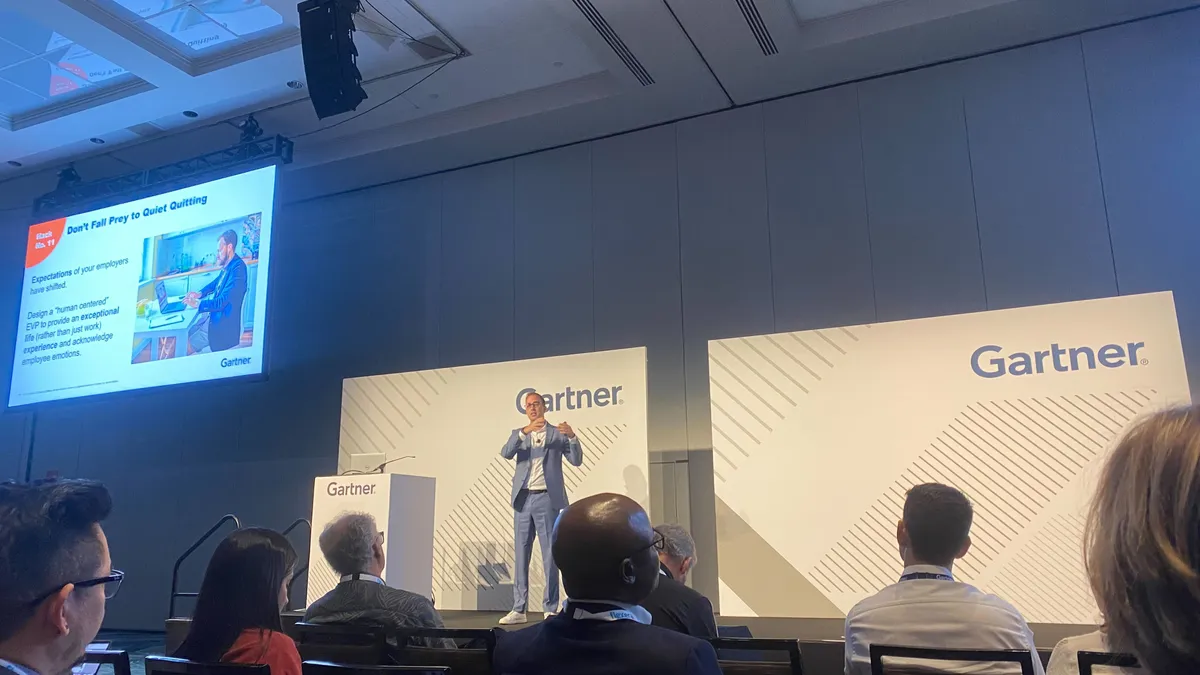ORLANDO, Fla. — To meet enterprise digital ambitions, CIOs need adequate budgets and an array of technology tools. They also need staff to work in harmony no matter where they're located.
The majority of companies are planning to implement some type of return-to-office policy by the end of next year, according to an August Resume Builder survey of 1,000 business decision-makers.
However, the push to bring employees back to the office could take a toll on worker retention. If enhancing productivity is the goal, leaders will need to do more than just require workers to come in a few days a week.
“Instead of trying to change everything at once, you need to begin with small, daily, incremental steps that you can take and affect the people around you and change your organization,” said Lane Severson, VP analyst at Gartner, speaking Monday during the Gartner IT Symposium/Xpo in Orlando, Florida. “That’s a culture hack.”
A culture hack is a low-effort, immediate, visible and emotional action that can help workers feel more engaged no matter where they or their colleagues are working, according to Severson. Here are four culture hacks pulled from Severson’s presentation:
1. Increase transparency
CIOs should foster engagement and create opportunities for transparency. Tactically, this can look like taking notes in a shared document during meetings for all to see, according to Severson.
Facilitating town hall meetings is also an effective engagement strategy. The key is to make them employee-led, said Severson.
“You don’t write the script for this,” Severson said. “They’re going to submit questions to you and maybe some of your executive staff, and you’re just going to answer the questions. We want to get people on screen, on mic.”
2. Break down virtual barriers
Uncomfortable silences are a common virtual meeting pitfall, but executives can lead by example to reduce friction.
“We know that it’s tough to build good relationships and friendships at organizations, so why don’t we just buy coffee for the new employee?” Severson suggested. Leaders can also break down virtual barriers by being intentional about how they present themselves in meetings.
“The biggest virtual barrier that I see leaders doing all the time is not looking at the person they’re talking to when they’re having a meeting, or being completely checked out when you’re not the person talking [during] the meeting,” Severson said.
Interacting as one would in person by waving, raising a hand or gesturing in agreement goes further than CIOs might think.
3. Reduce Meetings
Technology executives could take a more prescriptive approach and declare one or more meeting-free workdays per week or month. Another strategy is to cancel recurring meetings when there’s no agenda.
“Reevaluate your priorities and how much time you’re putting into something and the cadence at which you need to do that,” Severson said. “The big secret here is having the executive permission to do this.”
If typical meetings run for about an hour, Severson suggested challenging CIOs to hit 30 minutes. For half-hour meetings, try trimming five to ten minutes.
4. Don’t get trapped in productivity paranoia
There’s a growing number of executives focusing on the productivity of employees — or the perception of it — to an extent that’s harmful, according to Severson. It’s a phenomenon dubbed productivity paranoia, and it can fuel bad choices regarding how leaders interact with employees.
“For the past few years, people feel like their employees have not been working as hard remotely as they used to at one time, and certainly not as hard as we worked in this long-forgotten era when we all went to the office regularly,” Severson said.
If executives feel that their employees are not getting enough done, encourage documentation. Severson said this could look like asking what decision was made, what was delivered and what are next steps for that employee after the meeting via an automated poll or check-in.
Identifying key metrics is another way to encourage employees to focus on what the business finds important. In the service desk, for example, if the most important metric is the time it takes to resolve the call, then that should be communicated to the staff.
A data-driven approach to productivity can ease anxieties for both employees and executives, Severson said.





















